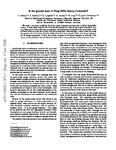Is the ground state of Yang-Mills theory Coulombic?
| dc.contributor.author | Heinzl, Thomas | |
| dc.contributor.author | Ilderton, A | |
| dc.contributor.author | Langfeld, K | |
| dc.contributor.author | Lavelle, Martin | |
| dc.contributor.author | Lutz, W | |
| dc.contributor.author | McMullan, David | |
| dc.date.accessioned | 2018-11-10T12:08:53Z | |
| dc.date.available | 2018-11-10T12:08:53Z | |
| dc.date.issued | 2008-08 | |
| dc.identifier.issn | 1550-7998 | |
| dc.identifier.issn | 1550-2368 | |
| dc.identifier.other | 034504 | |
| dc.identifier.uri | http://hdl.handle.net/10026.1/12747 | |
| dc.description | 10 pages, 9 .eps figures | |
| dc.description.abstract |
We study trial states modelling the heavy quark-antiquark ground state in SU(2) Yang-Mills theory. A state describing the flux tube between quarks as a thin string of glue is found to be a poor description of the continuum ground state; the infinitesimal thickness of the string leads to UV artifacts which suppress the overlap with the ground state. Contrastingly, a state which surrounds the quarks with non-Abelian Coulomb fields is found to have a good overlap with the ground state for all charge separations. In fact, the overlap increases as the lattice regulator is removed. This opens up the possibility that the Coulomb state is the true ground state in the continuum limit. © 2008 The American Physical Society. | |
| dc.format.extent | 034504- | |
| dc.language | en | |
| dc.language.iso | en | |
| dc.publisher | American Physical Society (APS) | |
| dc.subject | hep-lat | |
| dc.subject | hep-lat | |
| dc.subject | hep-ph | |
| dc.subject | hep-th | |
| dc.title | Is the ground state of Yang-Mills theory Coulombic? | |
| dc.type | journal-article | |
| dc.type | Journal Article | |
| plymouth.author-url | https://www.webofscience.com/api/gateway?GWVersion=2&SrcApp=PARTNER_APP&SrcAuth=LinksAMR&KeyUT=WOS:000258975300079&DestLinkType=FullRecord&DestApp=ALL_WOS&UsrCustomerID=11bb513d99f797142bcfeffcc58ea008 | |
| plymouth.issue | 3 | |
| plymouth.volume | 78 | |
| plymouth.publisher-url | http://dx.doi.org/10.1103/PhysRevD.78.034504 | |
| plymouth.publication-status | Published online | |
| plymouth.journal | Physical Review D | |
| dc.identifier.doi | 10.1103/physrevd.78.034504 | |
| plymouth.organisational-group | /Plymouth | |
| plymouth.organisational-group | /Plymouth/Faculty of Science and Engineering | |
| plymouth.organisational-group | /Plymouth/Faculty of Science and Engineering/School of Engineering, Computing and Mathematics | |
| plymouth.organisational-group | /Plymouth/REF 2021 Researchers by UoA | |
| plymouth.organisational-group | /Plymouth/REF 2021 Researchers by UoA/EXTENDED UoA 10 - Mathematical Sciences | |
| plymouth.organisational-group | /Plymouth/REF 2021 Researchers by UoA/UoA10 Mathematical Sciences | |
| plymouth.organisational-group | /Plymouth/Users by role | |
| plymouth.organisational-group | /Plymouth/Users by role/Academics | |
| dc.identifier.eissn | 1550-2368 | |
| dc.rights.embargoperiod | Not known | |
| rioxxterms.versionofrecord | 10.1103/physrevd.78.034504 | |
| rioxxterms.licenseref.uri | http://www.rioxx.net/licenses/all-rights-reserved | |
| rioxxterms.type | Journal Article/Review |


